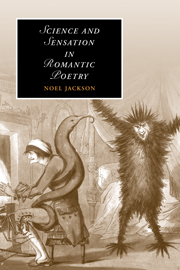Book contents
- Frontmatter
- Contents
- List of illustrations
- Acknowledgments
- List of abbreviations
- Introduction: Lyrical forms and empirical realities: reading Romanticism's “language of the sense”
- PART I SENSES OF HISTORY: BETWEEN THE MIND AND THE WORLD
- 1 Powers of suggestion: sensation, revolution, and Romantic aesthetics
- 2 The “sense of history” and the history of the senses: periodizing perception in Wordsworth and Blake
- PART II SENSES OF COMMUNITY: LYRIC SUBJECTIVITY AND “THE CULTURE OF THE FEELINGS”
- PART III THE PERSISTENCE OF THE AESTHETIC: AFTERLIVES OF ROMANTICISM
- Notes
- Select bibliography
- Index
- CAMBRIDGE STUDIES IN ROMANTICISM
1 - Powers of suggestion: sensation, revolution, and Romantic aesthetics
Published online by Cambridge University Press: 22 September 2009
- Frontmatter
- Contents
- List of illustrations
- Acknowledgments
- List of abbreviations
- Introduction: Lyrical forms and empirical realities: reading Romanticism's “language of the sense”
- PART I SENSES OF HISTORY: BETWEEN THE MIND AND THE WORLD
- 1 Powers of suggestion: sensation, revolution, and Romantic aesthetics
- 2 The “sense of history” and the history of the senses: periodizing perception in Wordsworth and Blake
- PART II SENSES OF COMMUNITY: LYRIC SUBJECTIVITY AND “THE CULTURE OF THE FEELINGS”
- PART III THE PERSISTENCE OF THE AESTHETIC: AFTERLIVES OF ROMANTICISM
- Notes
- Select bibliography
- Index
- CAMBRIDGE STUDIES IN ROMANTICISM
Summary
No single issue appears to arrive more quickly at the heart of recent debates about Romantic poetry than that concerning the nature of the Romanticist's attachment to it. For several decades now, literary scholars have considered whether Romantic scholarship might be better served by an oppositional relationship to its object of study than by an approach that assumes a standpoint of appreciative familiarity with the forms and pleasures of canonical Romantic aesthetics. Only rarely, however, have critics observed how these debates were anticipated by the Romantics themselves. In no other period of literary history, after all, have poets so carefully balanced their craft between the poles of tradition and experiment; no period before or since has appeared so paradoxically divided between the avowedly social ambitions of art and the intensely subjective form of its transmission. To read that inaugural document of canonical Romanticism, the Lyrical Ballads, is to confront a poetry that purports to unite its readership not in the first instance through communities of shared interest but rather through those “feelings of strangeness and aukwardness” of which Wordsworth warned the reader in the 1798 “Advertisement” – a poetry whose lofty ambition to “bind[] together … the vast empire of human society” is to be achieved, if at all, at an insistently personal level (LB 7, 259). Does our affective engagement with this literature blunt the discriminating faculties of the mind, threatening to lay asleep the powers of critique?
- Type
- Chapter
- Information
- Science and Sensation in Romantic Poetry , pp. 23 - 63Publisher: Cambridge University PressPrint publication year: 2008

